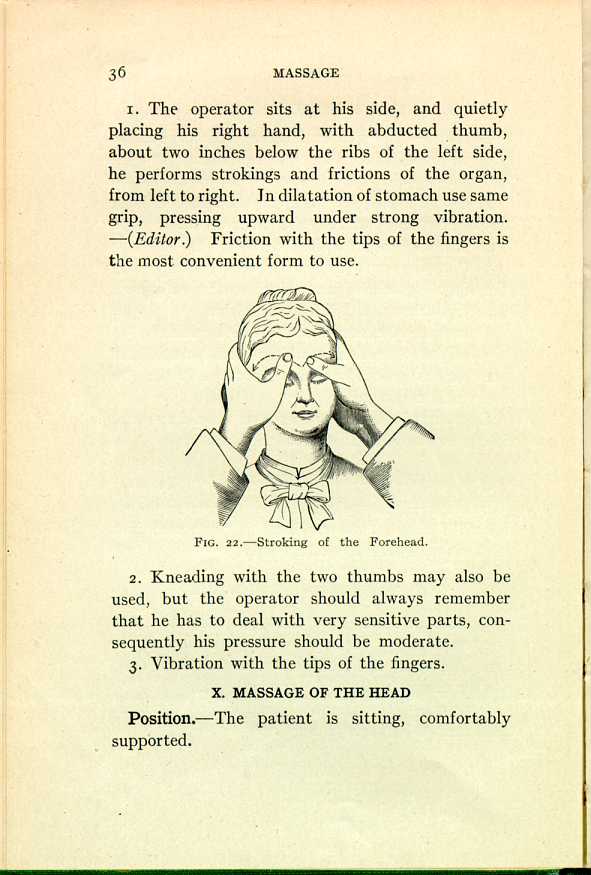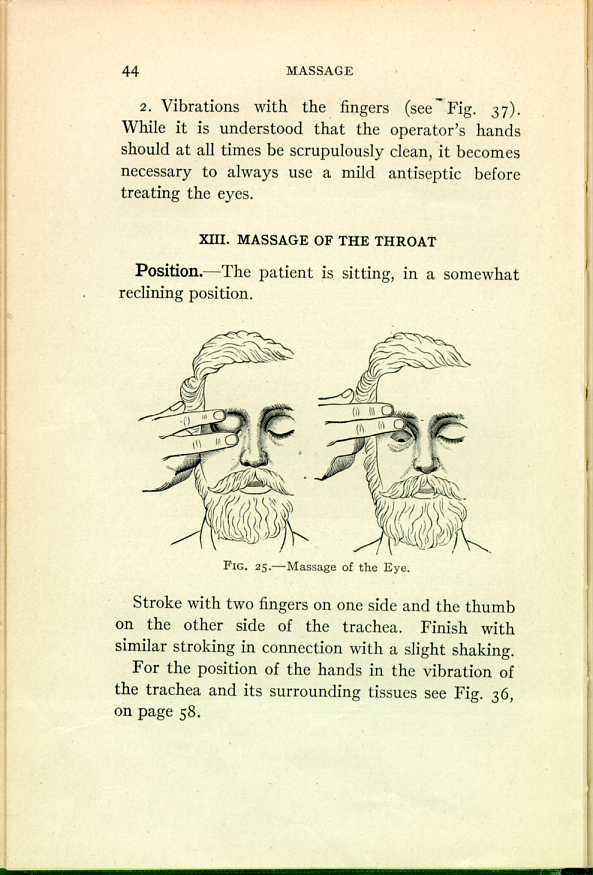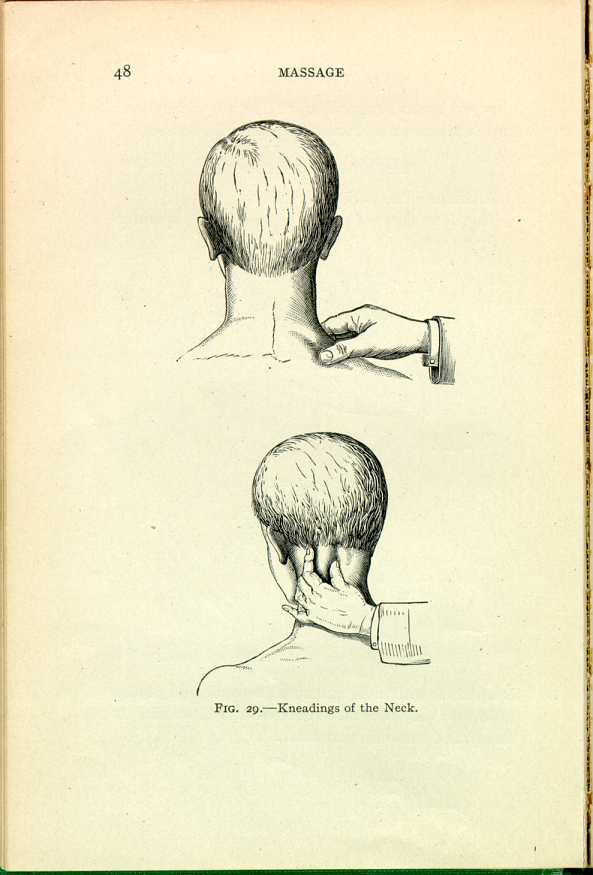| Massage and the Original Swedish Movements | ||
MASSAGE AS A THERAPEUTIC AGENT
is divided into Introductory, General and Local.
INTRODUCTORY MASSAGE
In many affections it is necessary to commence the operation of massage with what has been termed introductory treatment.
In the majority of cases of both acute and chronic affections of the joints it is well to apply the treatment to the neighborhood of the part, and especially above it. This is essential if the skin is abraded or if a severe inflammation of the part exists rendering it sensitive to too much pain from pressure.
The treatment consists of centripetal strokings (with one or both hands) in connection with a few kneadings.
Special attention should be paid to the inside parts of the extremities where the principal veins and lymphatics pass. If possible and convenient, always try to get the aid of gravity by elevation.
By this treatment we prepare the venous and lymphatic systems to absorb the diseased particles subsequently expelled from the affected part.
If for instance we have a case of synovitis of the
In the treatment of hemorrhoids by massage we should always commence by treating the liver, thereby procuring an outlet for the congested blood of the abdomen through the portal vein. When taken in time massage is really a specific in the treatment of hemorrhoids.
This is mentioned only to emphasize the importance of the introductory massage in all manual treatment. The success of massage used in joint affections will often depend upon how well and how judiciously the introductory treatment is applied.
GENERAL MASSAGE
By general massage we mean the treatment applied to the whole body, with the exception of the head.
The operator begins with the foot, stroking with one hand or kneading with the thumbs. Then he proceeds with the legs, the arms, the chest, the abdomen, and finally the back. All the manipulations may be used, and special attention should be
In regard to the time necessary to spend in giving general massage, I would advise the operator to begin with thirty minutes, and gradually increase the time so that one hour is consumed at the end of the first week. The length and the severity of the treatment should always be regulated by the patient's condition. General massage should not be employed until two hours have elapsed after meals; As soon as a part is operated upon it should be covered up at once.
LOCAL MASSAGE
By local massage we mean the treatment applied to the different parts of the body at one time; for instance, massage of the shoulder.
- Position.—The patient is lying or half lying on a bed or
couch. The operator sitting at his side performs the following
manipulations:
23
- 1. Stroking of the foot sole and dorsum; quick stroking with the palm of the hand to the sole of the foot finishing with firm and quick clappings with one hand, the other grasping the ankle underneath, so as to elevate the limb.
- 2. Stroking with both hands from the ankle to the hip, the hand on the outside reaching up to the crest of the ilium, the thumb of the hand on the inside, with moderate pressure, going down toward the groin. (Avoid pressure upon the tibia.)
- 3. Friction with the thumb upon the outside of the leg from ankle to knee-joint, covering principally the flexors of the foot.
- 4. Stroking with one hand of the same part.
- 5. Friction with the thumb upon the inside and posterior part of the leg, covering principally the gastrocnemius and the soleus.
- 6. Stroking with one hand of the same part.
- 7. Friction with the thumb or hand upon the outside, inside and the back part of the thigh, dividing it into four distinct parts so as to thoroughly work upon all the different muscles.
- 8. Repeated strokings over the whole extremity, from ankle to hip.
- 9. Kneading with the two thumbs or both hands upon the different muscles of the whole extremity.
- 10. Hacking or clapping upon the whole extremity, avoiding the bones.
I. MASSAGE OF THE LEG
In certain cases (dropsy, rheumatism, etc.),
The limb should be frequently turned, so that the posterior part may receive proper attention.
- Position.—The patient is sitting or lying, with the semiflexed arm supported, if convenient. The operator sits at the side.
- 1. Stroking with one hand on the outside of the arm, from the wrist to the trapezius. The other hand should support around the wrist, but care should be taken that no pressure be used over the radial artery, as that checks circulation considerably.
- 2. Stroking with the other hand upon the inside of the arm, from wrist to shoulder-joint, the thumb going out toward the pectoral muscles. Support is given in a similar manner as described in 1.
- 3. Friction with the thumb upon the extensors of the hand and fingers with repeated strokings of the same part.
- 4. Friction with the thumb of the other hand upon the flexors of the hand and fingers, with repeated strokings upon the same part.
- 5. Friction with the hand upon the arm proper.
- 6. Stroking of the whole arm, as described in 1 and 2.
- 7. Kneading with the two thumbs of both hands upon
different muscles, special attention being paid
to reach the extensors and flexors in the forearm, the biceps, triceps, deltoid, supraspinatus and infraspinatus.25
- 8. Hacking over the whole arm.
II. MASSAGE OF THE ARM
The most common mistakes in treating the arm are:
- 1. Too tight grasp around the wrist with the supporting hand.
- 2. The arm is kept too rigid, preventing the proper and necessary relaxation of the muscles.
- 3. The muscles of the upper part of the arm and shoulder are too often neglected.
- 4. Inefficient kneading.
- Position.—The patient is lying flat on the back, without head-rest, and the arms placed at the sides.
- 1. Stroking with both hands, one on each side of the sternum. The manipulation should be performed upward and inward, making a somewhat circular motion (see Fig. 2).
- 2. Friction with thumb over pectorales major and minor, with repeated strokings. Always from the origin (sternum) toward the insertion (the arm).
- 3. Kneading with the thumb and fingers (pinching) if the muscles of the one side be paralyzed.
- 4. Hacking or clapping over the chest may also be used, according to circumstances. Punctation in circles around the heart has also been recommended, but if used, great care should be taken.
III. MASSAGE OF THE CHEST
As a rule, all percussions applied to the thorax should be used with discretion.
In massage of the breast place the hands at the outer circumference and by alternate frictions proceed upward to the nipple. In cases of caked breasts it is often necessary to use frictions with the tips of the fingers over hard places to relieve distended ducts. Always finish the treatment with the so-called "fulling'' consisting of gentle pressure from the base of the breast upward with both hands alternately. Massage with camphorated oil is a great relief in over-distended breasts. The operator should always be careful not to bruise the glands in any way, as tumors are liable to develop in after years and cause no end of trouble. Massage and exercise are the only means by which the bust can be properly developed. The patient should be taught how to breathe properly and for the quick development of the mammary glands use in the massage as above described the following preparation, recommended by Dr. W. J. Haynes:
| Lanoline | 2 ounces |
| Cocoa Butter | 2 ounces |
| Oil Cajeput | 1 ounce |
| Oil Sassafras | 1/2 ounce |
| Extract Saw Palmetto | 2 ounces |
This preparation has not a fine odor, but produces a pleasant sensation in the skin. It is a valuable compound wherever we wish to develop a part, but should not be used on the face.
- Position.—The patient is lying on his face, without the head-rest, the arms should be kept at the sides.
- 1. Stroking with both hands, one on each side of the spinal
column, from the base of the skull
down to the sacrum. If on a large person, the operator had better divide the back into three parts, in such a manner as to first work next to the spinal column, then over the center of the back, and finally over the sides, remembering that by the last manipulation
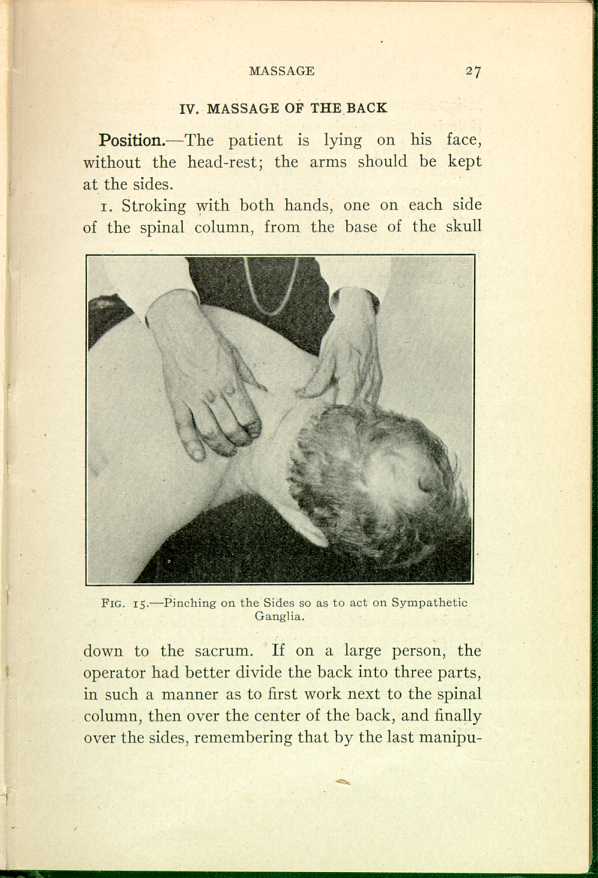
FIG. 15.—Pinching on the Sides so as to act on Sympathetic Ganglia.
[Description: Photograph of an operator pinching the back of a patient's neck. ]he may conveniently reach the liver or spleen, if desirable in certain cases. In the case of an infant, and especially in infantile paralysis, we often use in the stroking only the index and the middle fingers, one on each side of the spinal column.28 - 2. Friction with the hand or with the last two phalanges of the one hand, from the upper part of the trapezius down to the glutei, one side at a time.
- 3. Stroking as previously described.
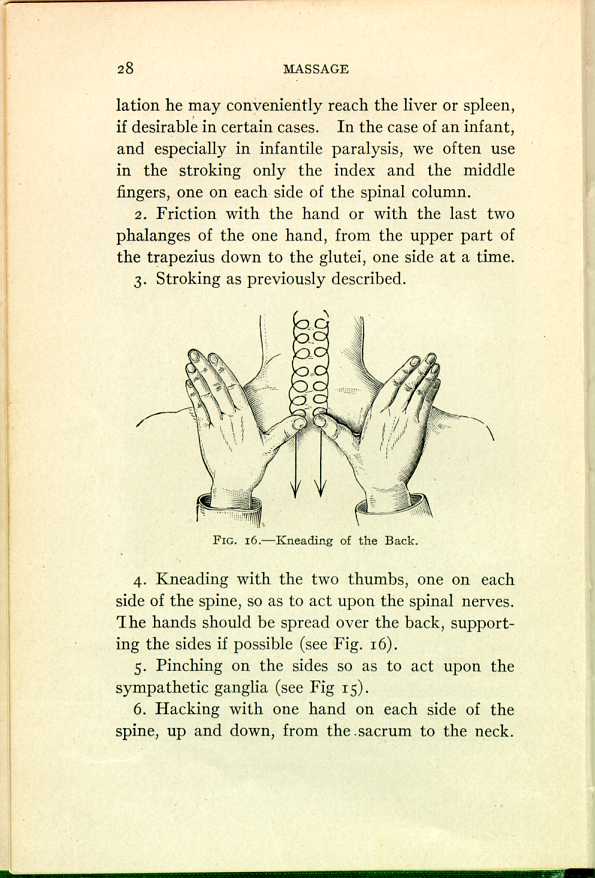
FIG. 16.—Kneading of the Back.
[Description: Drawing of an operator's hands kneading a patient's back. Circular lines indicated movement of the thumbs. ] - 4. Kneading with the two thumbs, one on each side of the spine, so as to act upon the spinal nerves. The hands should be spread over the back, supporting the sides if possible (see Fig. 16).
- 5. Pinching on the sides so as to act upon the sympathetic ganglia (see Fig 15).
- 6. Hacking with one hand on each side of the spine, up and
down, from the sacrum to the neck.
29
- 7. Clapping on both sides, lengthwise, one at a time (see Fig 17).
- 8. Stroking repeated; performed very quickly if we wish to
stimulate; very slowly and firmly if we wish the manipulation to have a
soothing effect.
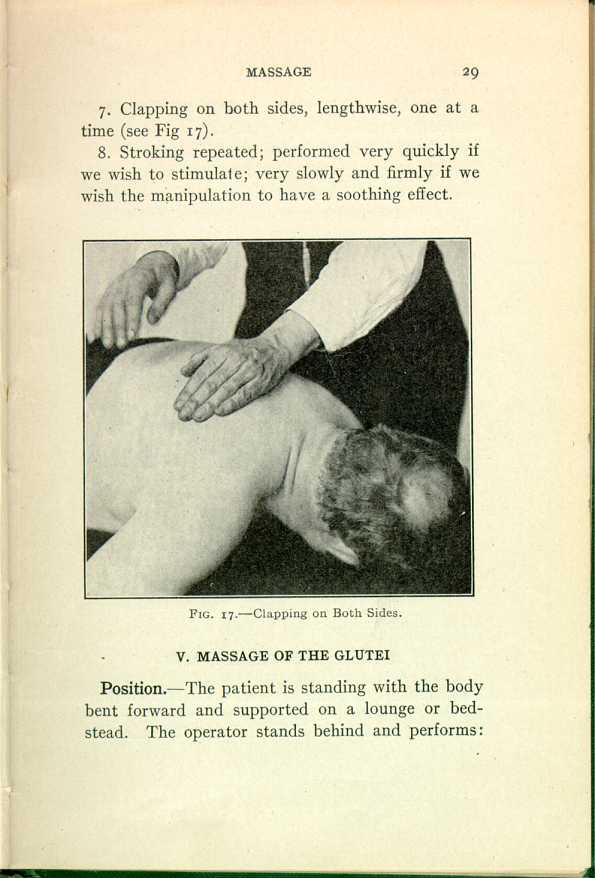
FIG. 17.—Clapping on Both Sides.
[Description: Photograph an operator's hands clapping a patient's back. ]
IV. MASSAGE OF THE BACK
- Position.—The patient is standing with the body bent
forward and supported on a lounge or bed-stead. The operator stands
behind and performs:
30
- 1. Stroking with both hands from the spine outward, downward (see Fig. 18).
- 2. Friction with the hand; one side at a time.
- 3. Beating in circles, one side at a time.
V. MASSAGE OF THE GLUTEI
If the patient is suffering severe pain from standing the manipulation
may be performed while he is
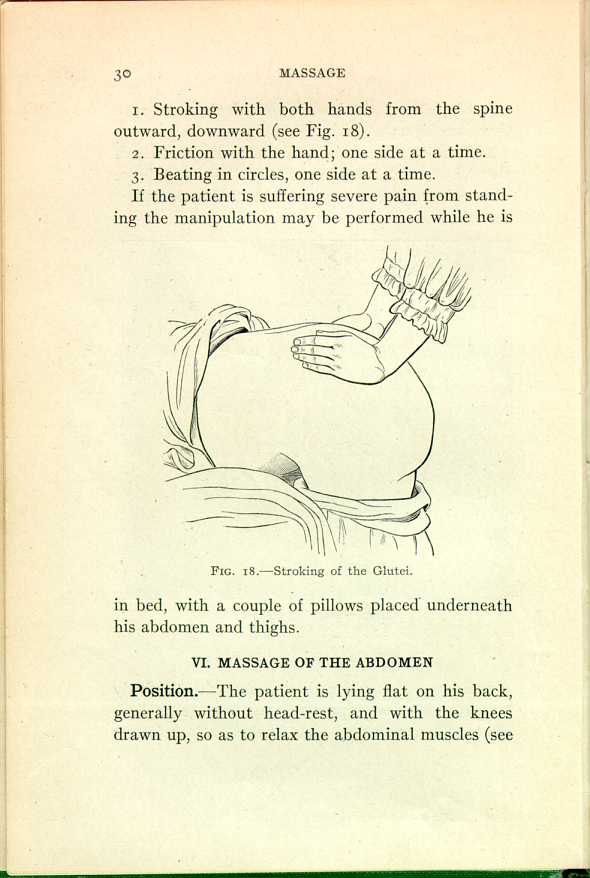
FIG. 18.—Stroking of the Glutei.
[Description:
Drawing of two hands stroking a patient's buttocks.
]
- Position.—The patient is lying flat on his back generally
without head-rest, and with the knees drawn up, so as to relax the
abdominal muscles (see
Fig. 19). It is most convenient for the operator to sit at the patient's right side.31
- 1. Friction with the tips of the fingers in circles from right to left over the umbilical region of the abdomen, thereby acting upon the smaller intestine. Begin with a very gentle pressure, gradually increasing the strength of the manipulation (see Fig. 20).
2. Spread the right hand over the abdomen so that the ball of the hand covers part of the ascending colon; press over that part upward to the transverse
colon; then stroke with the radial border of the hand firmly over to the left side. Here the tips of the fingers should be used for the downward pressure over the descending colon. The manipulation is repeated in circles without interruption (see Fig. 21).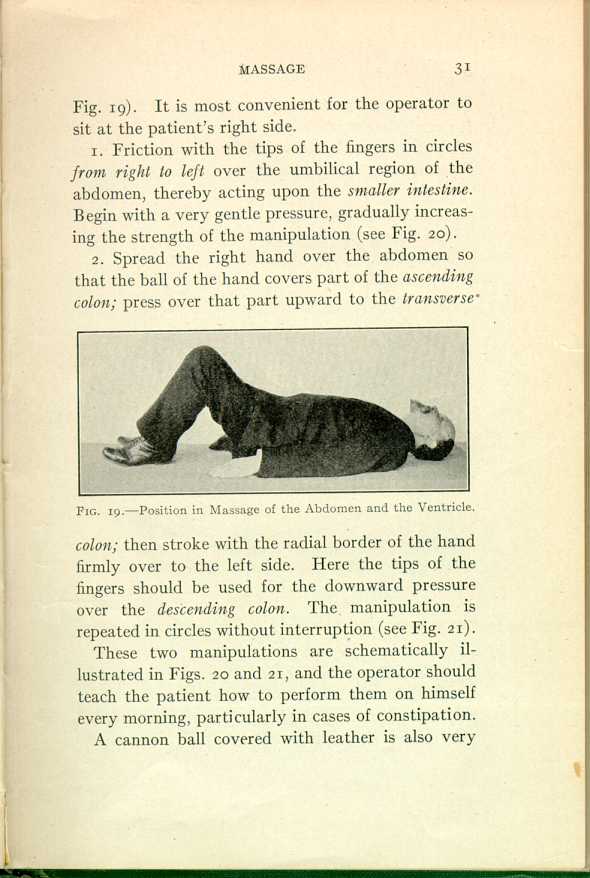
FIG. 19.—Position in Massage of the Abdomen and the Ventricle.
[Description: Photograph of a man lying on his back with his knees raised. ]These two manipulations are schematically illustrated in Figs. 20 and 21, and the operator should teach the patient how to perform them on himself every morning, particularly in cases of constipation.
A cannon ball covered with leather is also very
useful in manipulation No. 2, when the patient for some reason is obliged to do it himself. They can be procured from Charles Lentz and Sons, Philadelphia.32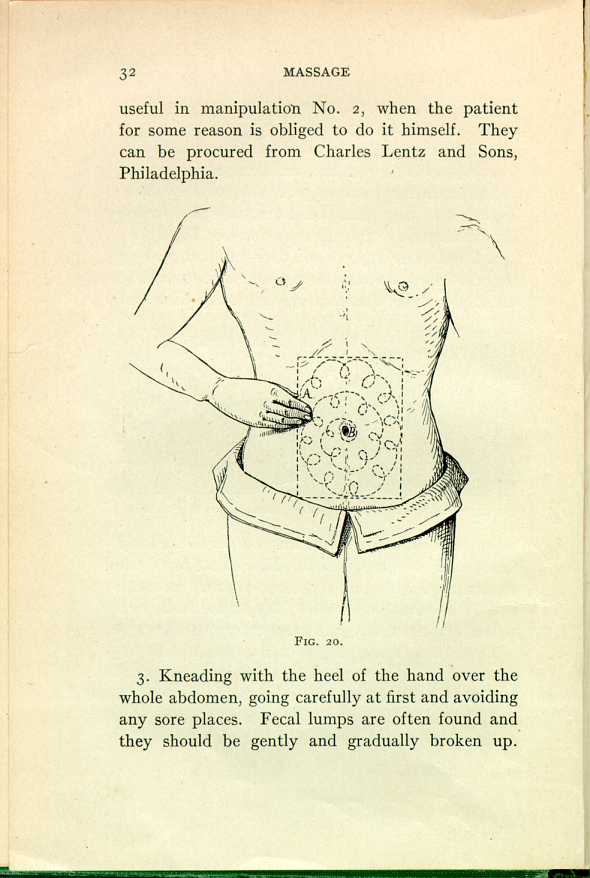
FIG. 20.
[Description: Drawing of a hand massaging the abdomen in circular motions. Dotted lines indicate movement. ]3. Kneading with the heel of the hand over the whole abdomen, going carefully at first and avoiding any sore places. Fecal lumps are often found and they should be gently and gradually broken up.
Near the sigmoid flexure we can sometimes accomplish more by substituting this manipulation for that of the friction with the tips of the fingers. The reason for that is that we can reach in deeper and33our efforts become more localized. The same refers to the breaking up of adhesions around the appendix and the ovaries.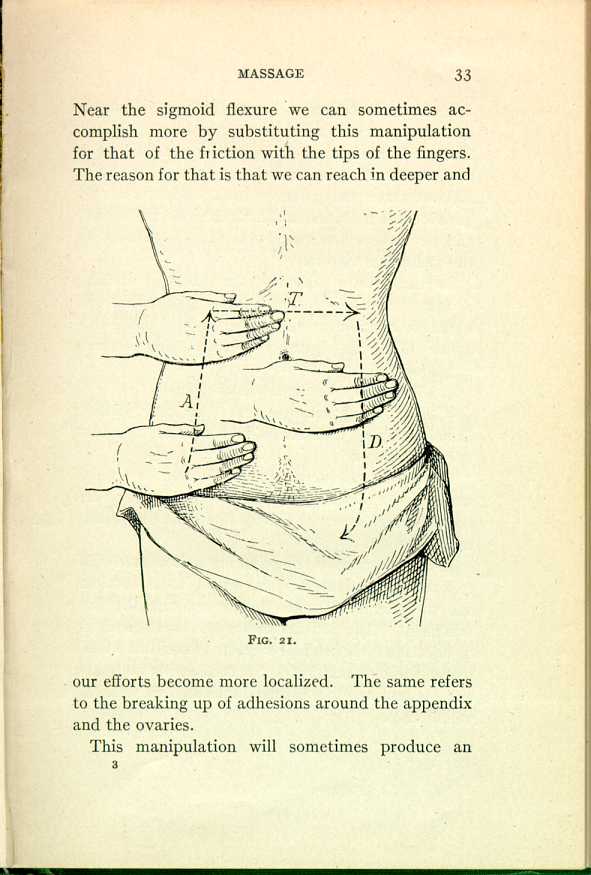
FIG. 21.
[Description: Drawing of a hand massaging the abdomen. Dotted lines indicate movement. ]This manipulation will sometimes produce an
unpleasant sensation at first, which is frequently caused by the patient not breathing properly. Talk to him so as to make him forget that he is being treated. Some operators place one hand as a support under the patient's back, and it is a very good idea, as the manipulation feels more comfortable and we have a better and more fixed control over the abdominal viscera.34- 4. Vibrations over the descending colon.
- 5. Turn the patient on his face and perform firm beating of the sacrum in circles so as to act upon the rectum.
VI. MASSAGE OF THE ABDOMEN
Massage of the abdomen must never be applied soon after a meal is partaken of. It is well to tell the patient to evacuate the bladder before beginning the treatment.
In chronic cases of constipation it is a good plan to have the patient take an enema, so as to clean out the sacculated colon before starting the first treatment. The indiscriminate and continued use of injections will produce a relaxed condition of the bowel, while on the contrary massage will strengthen and stimulate to normal activity its various membranes.
- Position.—The patient is lying half way turned over on his left side. The operator sits at his right side.
- 1. Friction with the palm of the hand in large circles covering gradually the entire organ.
- 2. Kneading with the heel of the hand.
- 3. Clapping over the entire organ, firmly over the right hypochondriac region, more gently over the epigastrium and left hypochondrium.
- 4. Palmar vibration over the different lobes.
- 5. Digital vibration, working the separated and bent fingers gradually under the curve of the ribs and costal cartilages.
VII. MASSAGE OF THE LIVER
Deep respiratory exercises are very important in connection with massage of the liver.
- Position.—The patient should, of course, lie on his right side. This treatment is performed in a similar way as massage of the liver.
VIII. MASSAGE OF THE SPLEEN
- Several methods have been proposed to reach the ventricle by massage. They are all more or less dangerous, and we mention one of them only, for the completeness of the system.
- Position.—The patient is lying flat on his back, as
described on page 31, Fig. 19.
36
1. The operator sits at his side, and quietly placing his right hand, with abducted thumb, about two inches below the ribs of the left side, he performs strokings and frictions of the organ, from left to right. In dilatation of stomach use same grip, pressing upward under strong vibration.
—(Editor.) Friction with the tips of the fingers is the most convenient form to use.
- 2. Kneading with the two thumbs may also be used, but the operator should always remember that he has to deal with very sensitive parts, consequently his pressure should be moderate.
- 3. Vibration with the tips of the fingers.
IX. MASSAGE OF THE STOMACH
- Position.—The patient is sitting, comfortably supported.
37
- 1. Stroking.—Beginning with the back of the head, keeping the left hand firmly on the forehead, and with the right in a V-shape, stroke downward. In stroking the forehead place the thumbs between the eyebrows and stroke firmly over the temples to the ears, both thumbs working together, so as to act upon the supraorbital nerve (see Fig. 22).
2. Friction with the one hand, the other supporting, on the diagonally opposite part of the head.
I have always found it best and most expedient to divide the head into four divisions for applying this manipulation, always beginning with the back part of the right side.
- 3. Friction with the tips of the fingers pressing firmly so as to move the scalp and to prevent breaking off the brittle or weakened hairs. This manipulation is particularly valuable when we work in a hair tonic. By working the scalp we draw the blood to the hair-roots (see Fig 23).
- 4. Hacking is used with both hands striking together, making circles over the head, beginning on the top and moving backward, downward, and forward to the starting point.
X. MASSAGE OF THE HEAD
For increasing the hair growth the author has never found anything to equal the following treatment. Shampoo the head freely with a good, pure tar soap and let the lather remain for two hours, then wash it off with warm water, adding a little of some good tonic. Now massage the scalp thoroughly with crude petroleum and allow that to stay on
The author has experimented lately with the new oxygenated petroleum
product, "Petrogen'' (Wyeth),
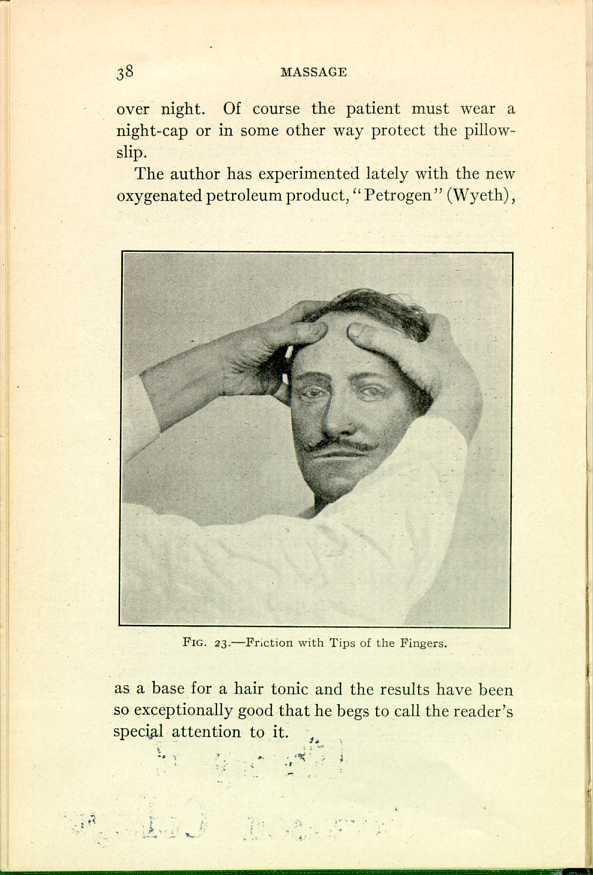
FIG. 23.—Friction with Tips of the Fingers.
[Description:
Photograph of two hands massaging a patient's forehead.
]
- Position.—The patient is lying or sitting with the head comfortably supported. Tell him to relax the muscles of the head and neck.
- 1. Stroking with the two thumbs over the forehead, starting near by the eyebrows gradually in succession working up to the hair-roots as in Fig. 22.
- 2. Friction with the tips of the fingers in small circles, the other hand being used to stretch the part worked upon; for this manipulation divide the forehead in two sections vertically. This is principally applied with the object of overcoming wrinkles of the forehead.
- 3. Repeated stroking as in No. 1, the operator being careful to tightly grasp the temples, so as to make the patient feel that the head is properly supported.
- 4. Stroking with the tips of the fingers over and below the eyes from the nose outward to the temples, both sides at a time.
- 5. Friction with the tips of the fingers over the same part with special attention to the outer corner of the eye and below it, where we generally find the so-called "crow feet.'' Stretch the part with the thumb and fingers of one hand, and perform the friction with the tips of the fingers of the other hand.
- 6. Repeated strokings as in No. 4.
- 7. Stroking with the two index-fingers over the nose from
the eyebrows downward and outward.
Raise the hands up high and hold them so during the manipulation from start to finish. In other words, the heel of the hand should be on a level with the tip of the finger.40
- 8. Stroking with both hands one on each side of the face from the extreme lower part of the inferior maxillary region well up to the temple. We stroke upward because the face frequently presents a drawn and pulled-down appearance; particularly so after a prolonged illness or a siege of nervous worry or tension.
- 9. Friction and kneading of the cheeks, picking up the muscles as much as possible, always remembering that the orbicularis oris is the insertion of most all the principal facial muscles.
- 10. Repeated strokings as in No. 8, only the patient is told to inflate his cheeks and to retain the air, breathing freely through his nose.
- 11. Stroking with the fingers around the lips and chin.
- 12. Frictions with the tips of the fingers over the same part of kneading if our object is to remove superfluous fat. In the latter case never use any fatty ointment, but instead some benzoin preparation that will help to contract the tissues.
- 13. Strokings repeated, as described in No. 11.
XI. MASSAGE OF THE FACE
In treating wrinkles the operator should remember that they are not, as a rule, caused by some trouble in the skin itself, but mostly always by a relaxed or weakened condition of the underlying muscular tissues;
| Oil of Sweet Almonds | 2 ounces |
| Spermaceti | 1/4 ounce |
| White Wax | 1/4 ounce |
| Orange fl. water | 1/2 ounce |
It will be noticed that there are no mineral fats amongst the
ingredients. Care should be taken to see that the genuine spermaceti and
wax be used, as both these preparations are "made'' from coal oil and
we should not be willing to risk
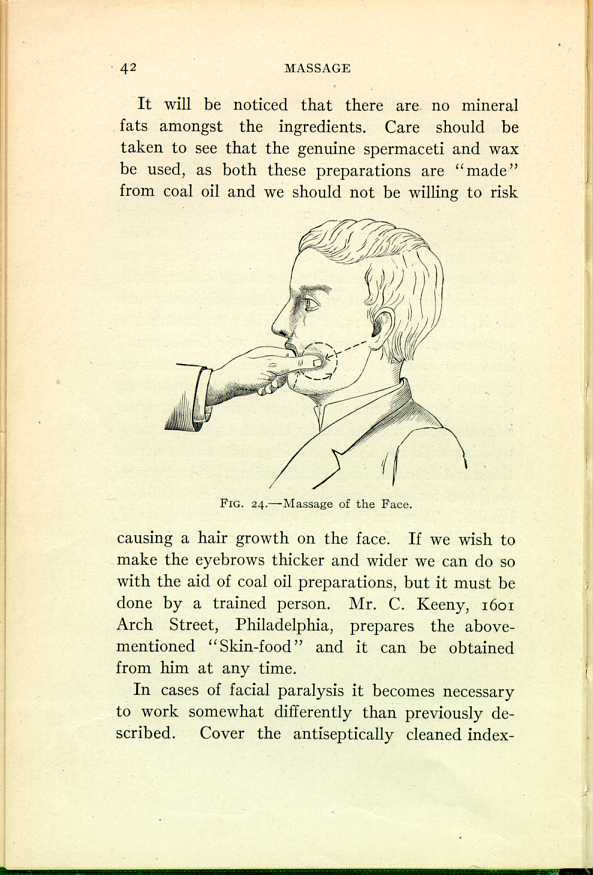
FIG. 24.—Massage of the Face.
[Description:
Drawing of an operator's hand massaging a man's mouth.
]
In cases of facial paralysis it becomes necessary to work somewhat differently than previously described. Cover the antiseptically cleaned index-finger
There are now many different vibrators on the market and the masseur should have at least one of them. Most of them are run by power obtained from the electric street current. Unfortunately this form of massage has been taken up by the barbers, many of whom use it without thought and discretion.
- Position.—The patient sits with the head leaning backward, the operator standing at his side.
1. The index-finger is placed on his eyebrow, the middle finger grasping the eyelid, which is pressed, with either a radial or circular motion, against the eye. Be very careful not to use too much strength, and perform the movement as quickly as possible (see Fig 25).
By placing the index on the eyebrow we take the weight of the heavy hand off the tender organ. The lid really performs the massage by pressure generated through the finger.
44- 2. Vibrations with the fingers (see Fig. 37). While it is understood that the operator's hands should at all times be scrupulously clean, it becomes necessary to always use a mild antiseptic before treating the eyes.
XII. MASSAGE OF THE EYE
Position.—The patient is sitting, in a somewhat reclining position.
Stroke with two fingers on one side and the thumb on the other side of the trachea. Finish with similar stroking in connection with a slight shaking.
For the position of the hands in the vibration of the trachea and its surrounding tissues see Fig. 36, on page 58.
45
XIII. MASSAGE OF THE THROAT
Position.—The patient faces the masseur (see Fig. 27) with the head thrown back, so as to expose the neck. The operator places his hands at the lobes
of the ears and performs a stroking downward to the shoulder. The patient should be told to breathe freely and easily. This method (originated by Dr. Gerst) is used principally to increase the circulation in the veins of the neck.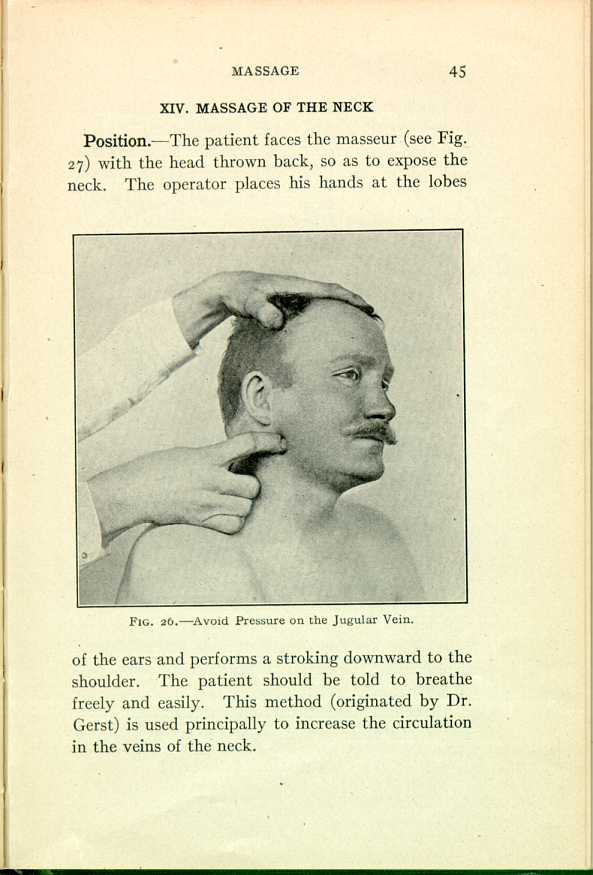
FIG. 26.—Avoid Pressure on the Jugular Vein.
[Description: Photograph of an index finger applying pressure on a man's jugular vein. ]46Another method of massage of the neck has been recommended by Hoeffinger. The patient is sitting with the head erect. The operator stands behind and places his hands underneath the patient's
ears. The stroking is performed downward toward the shoulder, the hand covering the principal part of the trapezius (see Fig. 28).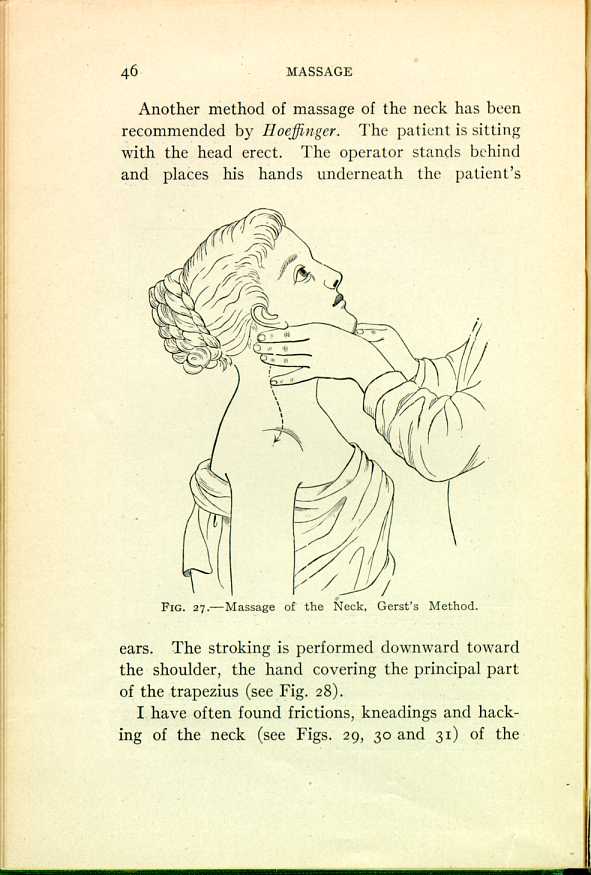
FIG. 27.—Massage of the Neck, Gerst's Method.
[Description: Drawing of an operator's hands massaging a woman's neck from the front. ]I have often found frictions, kneadings and hacking of the neck (see Figs. 29, 30 and 31) of the
greatest benefit, especially in cases of congestions and headaches, as recommended by Reibmayer.47
XIV. MASSAGE OF THE NECK
Position.—The patient reclining.
The forefinger of each hand of the operator
is applied, with mild pressure, to each side of the nose, of the patient. A stroking downward is slowly and carefully performed.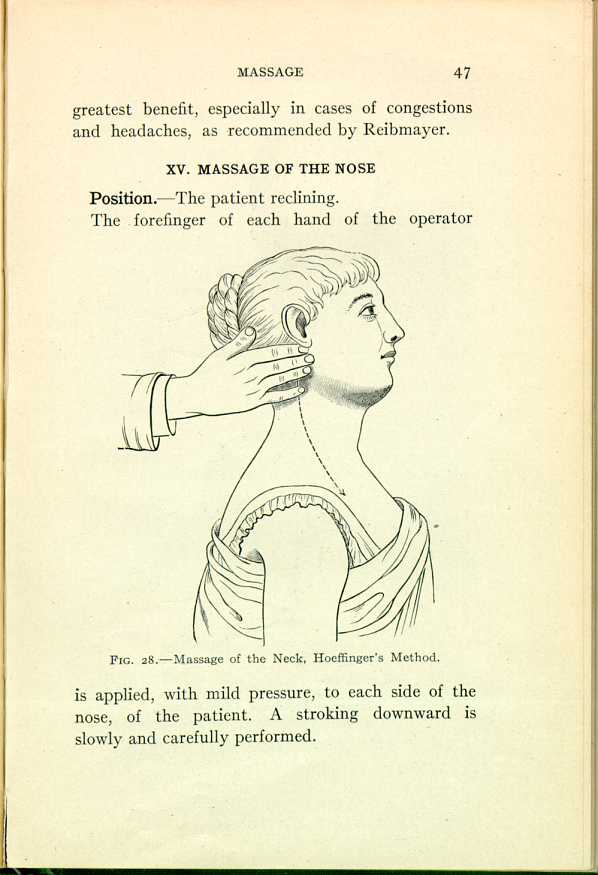
FIG. 28.—Massage of the Neck, Hoeffinger's Method.
[Description: Drawing of an operator's hand massaging a woman's neck from the back. ]4849In removing scars on or near the nose stretch the part and work crosswise, as described under massage of the face.
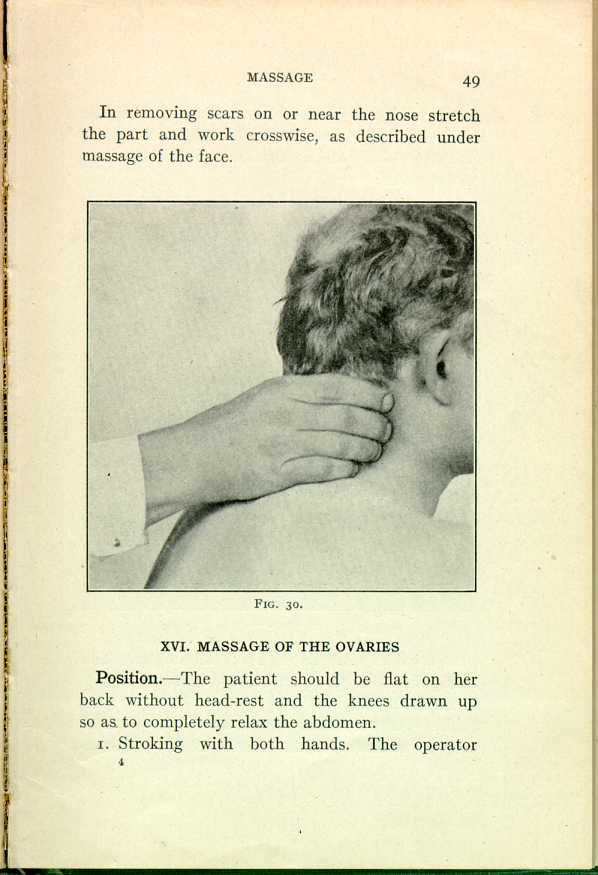
FIG. 30.
[Description: Photograph of a hand massaging a man's neck. ]
XV. MASSAGE OF THE NOSE
- Position.—The patient should be flat on her back without head-rest and the knees drawn up so as to completely relax the abdomen.
- 1. Stroking with both hands. The operator
stands with her back to the patient placing her hands near the crests of the ilium, stroke simultaneously with both hands downward and inward to the center.50
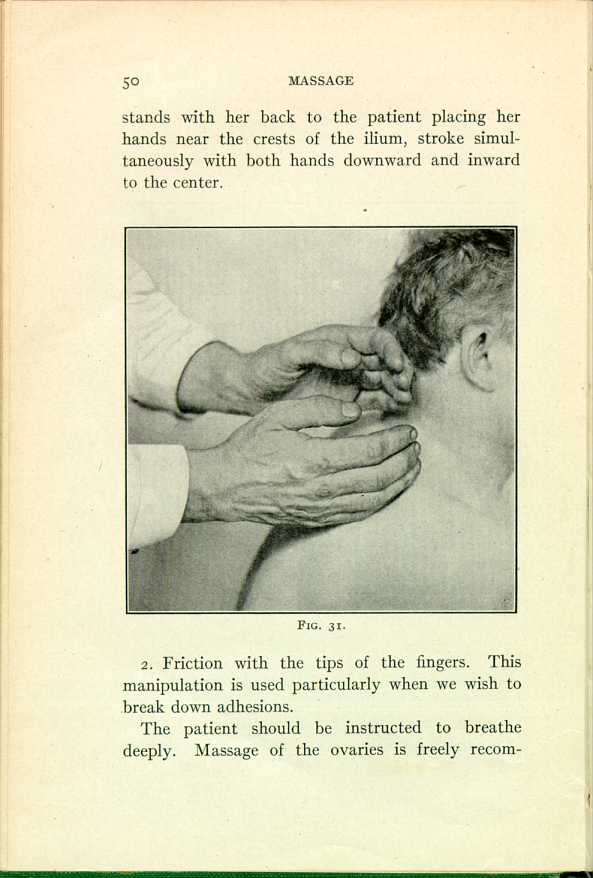
FIG. 31.
[Description: Photograph of an operator's hands "hacking" the back of a man's neck. ] - 2. Friction with the tips of the fingers. This manipulation is used particularly when we wish to break down adhesions.
XVI. MASSAGE OF THE OVARIES
The patient should be instructed to breathe deeply. Massage of the ovaries is freely recommended
- Position.—The same as for massage of the abdomen (see Fig. 19, page 31).
1. The external method is merely a modification of the massage of the abdomen. The patient must be in a half lying position, with the knees flexed in order to relax the abdominal muscles. Begin with the circular manipulations, from right to left, following with stroking and friction over the lower part of the abdomen.
It is generally used for atony of the uterine organs, and must always be succeeded by percussion or beating of the lower part of the back. The Swedish movements are a valuable auxiliary, controlling as they do, the circulation in the abdomen and the lower extremities. The massage increases the current in the blood-vessels and the lymphatics, the resorption is restored, and the muscular organs in the smaller pelvis are strengthened.
Special manipulation of the intestines relieve the bowels, which in cases of uterine affections must be of great importance.
- 2. A second method is rather difficult to perform,
as one or two fingers must be inserted in the vagina or the rectum,
against which we work from
the outside. It should be performed only by a person who has a thorough knowledge of the parts; in fact it belongs to the practice of the gynecologist alone. Dr. Homer C. Bloom, of Philadelphia, has written a valuable little pamphlet on "Pelvic Massage.'' He describes the treatment and furnishes reports of some few cases. There is one part which is particularly interesting to every scientific masseur. Dr. Bloom, after summarizing the results, says: "It has been noticed that, in a great number of these cases, there was a concomitant condition of hemorrhoids, which were relieved in every instance.''52
XVII. MASSAGE OF THE UTERUS
Dr. Norstrom, in Paris, recommends in massage of the uterus:
- 1. Graduate the pressure of the uterine body after you have seized it.
- 2. In order to get a good hold, push down during expiration; maintain the distance gained during inspiration and start again during the next expiration.
- 3. Be careful not to increase by any sudden movements, the painful impression experienced by the patient when the uterus is first taken hold of; wait a moment before beginning pressure. The pressure sometimes produces reflex pains in various parts of the body.
- 4. Devote all your attention to supporting the uterus. This
is easy when it is large and soft; very difficult when it is small and
hard; it is then that it moves with great facility to one side or the
other.
53
Any one specially interested in uterine massage will find a great deal of valuable information in a book published by Dr. Rob. Ziegenspeck, of Münich, and translated into English by Dr. F. H. Westerschulte, of Chicago. In this book Major Thure Brandt's methods are carefully analyzed and illustrated.
Two methods are used, one external and one internal. In the first the patient is placed flat on his back, holding himself, the reproductive organs stretched up on the abdomen. The perineum is massaged with strokings and frictions.
In the other method the operator inserts his covered middle or if necessary index-and middle-finger, with some lubricant on the finger, cold cream or pure fresh lard, in the patient's rectum; and fixing the gland he supports it from the inside while the thumb and the fingers of the other hand perform the manipulations. The bladder should always be evacuated before beginning the treatment.
Some forms of vibrations have proved very useful, particularly when applied through the rectum internally.
54
XIII. MASSAGE OF THE PROSTATE GLAND
| Massage and the Original Swedish Movements | ||
